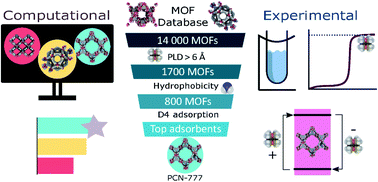Breaking the upper bound of siloxane uptake: metal–organic frameworks as an adsorbent platform†
Abstract
Biogas, regarded as a promising renewable energy source, still needs to be upgraded. This calls for the removal of the most prominent contaminants, among others the octamethylcyclotetrasiloxane (D4) molecule. Herein, high throughput computational screening in tandem with synthesis and adsorption testing revealed the hydrophobic Zr-MOF PCN-777 as an optimal D4 adsorbent with record gravimetric (1.8 g g−1) and volumetric (0.49 g cm−3) uptakes, alongside a reversible and fast adsorption/desorption process, good cyclability and easy regeneration. This MOF was demonstrated to encompass an ideal combination of mesoporous cages and chemical functionality to enable an optimal packing of the siloxane molecules and their efficient removal while maintaining the process as highly reversible thanks to moderately high host/guest interactions. This work highlights the efficacy of an integrated workflow for accelerating adsorbent selection for a desired application, spanning the entire pipeline from method validation to computational screening, synthesis and adsorption testing towards the identification of the optimal adsorbents.



 Please wait while we load your content...
Please wait while we load your content...